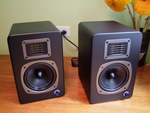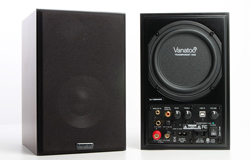
Introduction to the Vanatoo Transparent One Speakers
The last several years have seen an explosion in digital and streamed audio – never before has it been cheaper or easier to distribute audio around ones house or apartment. From the advent of protocols like Apple’s Airplay or Pandora, to the availability of hardware like the Logitech Squeeze Box or Sonos, getting digital audio and moving it from one place to another is as accessible and easy as it has ever been. At the same time this revolution has taken over, we’ve also seen an explosion on the availability of high quality audio components manufactured and marketed by companies directly to consumers over the internet, giving even the most ardent audiophile access to gear of incredible quality at shockingly low prices.
The convergence of all of these trends is manifest in the new Transparent One speaker. The Transparent One’s are manufactured and marketed directly to consumers by Vanatoo, the brainchild of Gary Gesellchen and Rick Kernen, two long-time audiophiles from Washington.
Gary and Rick had a simple realization: getting the bits around the house had become easy, whether you use a system based around Sonos, Apple, Logitech or even a DNLA device like the Western Digital TV. What was lacking were competent, audiophile quality speaker, with a small footprint, that gave people the flexibility to adopt whatever system the user wanted that possessed everything you’d need to get quality sound. What that meant was building a speaker that had everything – quality D/A conversion, quality amplification, and, most importantly, excellent sound. By building these into one complete system, the user could use any method to get the music to the desired location and then Transparent One would take care of the rest.
Vanatoo Transparent One Speakers SPECIFICATIONS
- Design: 2-way with Passive Radiator; Active (Built-in Amplifiers)
- Drivers: One 1” Silk Dome Tweeter, One 5.25” Woofer, One 5.25″ Passive Radiator
- MFR: 48 Hz – 20K Hz ± 3dB
- Amplifiers: 60 Watts RMS x 2
- Input Connectors: Analog – 3.5mm, Digital – Toslink Optical, Coax, and USB audio
- Finish: Black or Natural Cherry (Wood)
- Dimensions: Speaker with Amplifier: 10” H x 6.5” W x 8.1” D; Speaker without Controls is 7.5″ D
- Weight: Speaker with Amplifier: 12 Pounds; Speaker without Amplifier: 11 Pounds
- MSRP: Black $499, Cherry $549 USD
- Vanatoo
- SECRETS TAGS: Audio, Speakers, Vanatoo, Passive Radiator
Design of the Vanatoo Transparent One Speakers
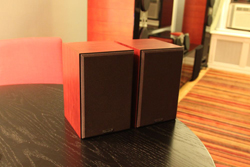
Gary and Rick sent over a pair of Transparent One’s in Cherry color. The speakers have a solid feel and appear to have nice build quality. While the overall look of the speakers might not turn heads (the size and appearance is pretty routine and one might say conservative), they’ll likely fit into most rooms and decor without many arguments from the aesthetics committee. Removing the front speaker panel, I was greeted with a woofer and tweeter. I might have preferred that the speaker grill had magnetic attachments vs. the push kind I found here, but this is a small quibble.
From the back the dominant feature is the passive radiator. Below that are several controls and various digital inputs (Coax and Optical), as well as an Analog and USB inputs. There are nobs to control bass, treble and volume. There are also speaker terminals: Only one of the Transparent One’s is actually an active speaker – the second speaker is passive. In order to set up the system, speaker wire is included to run from the powered unit to the unpowered unit. Lastly, there is a power output. This, I thought, was a really nifty inclusion. The Transparent One is meant to be paired with some sort of streaming device like the Apple Airplay, a Sonos or a Logitech Squeeze Box. By including a power port on the back of the Transparent One, only one power cord needs to be run to the wall.
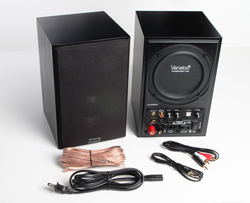
Internally, the Transparent One’s are powered by a Class D amplifier from D2Audio. Gary and Rick tell me they listened to many different Class D products before choosing the D2Audio unit. What makes this unit unique isn’t just the sound; this chip also provides integrated digital signal processor (DSP), the ability to support direct digital inputs and tone controls. All of these features are taken advantage of in the speakers. For example, the Transparent One’s utilize the DSP to specifically process incoming audio to match the drivers for a nice, flat response.
Setup of the Vanatoo Transparent One Speakers
I placed the Transparent One’s on my BDI Mirage TV stand on either side of my Usher Center Channel. Gary and Rick indicated that optimal would place the users ears slightly above the tweeter, so the stand worked perfectly. I would have hoped that the speakers would have had some rubber feet – unfortunately my unit did not have any feet installed to protect the furniture so I placed down some sorbothane pads to protect the stand. These might have been missing from my review pair.
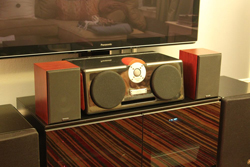
A speaker wire is included to run between the powered speaker and its brother – which I ran inconspicuously behind my center channel. From there all that was left was some source music. Gary and Rick included an Apple AirPlay unit for me to play with – this plugged conveniently into the back of the Transparent One’s power source. I also tested a Logitech Squeezebox. As the instructions suggest, I used some streaming audio from my favorite internet radio station (wMVY from Martha’s Vineyard) to set the volume on the back of the powered speaker. From there I was ready to start listening.
Vanatoo Transparent One Speakers In Use
I started, true to fashion, with some downloaded material from Phish’s recently completed summer tour. I began with some tracks from the tour closer from Denver’s Dick’s Sporting Good Park, recorded in early September. For several years now Phish has been posting high quality, 24/48 FLAC files for download. This is what I used here. I queued this up using the Squeezebox and my iPhone and sat back to take a listen.

I dove straight into the second set for a challenge for the Transparent One’s with Story of the Ghost; I figured Mike Gordon’s strong bass-line would be difficult for speaker of such a small size, but I was delightfully surprised. Not only did the Transparent One’s handle the bass just fine, they actually excelled. The intro beats were tight and clean and much more substantial than anything I’ve heard from a speaker this small. At the same time, the mid-range was balanced nicely, with clear and pleasing vocals. Pumping up the volume a bit, I found the Transparent One’s had quite a bit of headroom – these guys will play loud if you need them to without distortion.
I wanted to switch gears a little so I next queued up perhaps one of the biggest albums of last year: Adele’s “21”. The tracks I used were FLACs created directly from our copy of the CD. The strong vocals from “Someone Like You” sounded terrific on the Transparent One’s. Again, I’ was shocked by how much good quality sounded was being produced from something so small. Adele’s vocals never sounded thin like one normally hears from a smaller speaker.

The track “Rolling in the Deep” has a nice thumping beat that keeps things going, and while you won’t maybe get the visceral feeling that full range speaker can give, there was enough that I didn’t feel like I was missing anything from the track. If you do feel like you’d like more bass from the Transparent One’s, there is a sub output on the back of the primary speaker. I didn’t test this feature during my evaluation.
I was curious how Gary and Rick pulled off this level of tight bass from such a small package. The Transparent One’s include a technology that is titled “ClearBass” and it seems like one of the parts of the speakers they are most proud of. Using a combination of a custom designed woofer and a high displacement passive radiator coupled with the DSP found in the D2Audio chip, Gary and Rick were able to get clean and powerful bass from a speaker of exceptionally modest size.
Getting back to the music, I wanted to listen to one more pop track before switching genres a little. Perhaps my wife and my current favorite is the new Mumford & Sons album Babel. I started with the very popular “I Will Wait”, curious to see how well the Transparent One’s kept up the fast guitar and banjo playing found in this track.
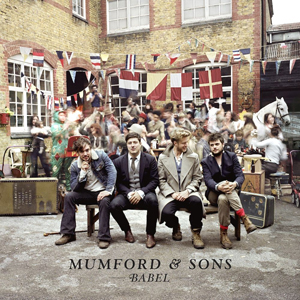
Speed and cleanliness is definitely one of the positives with Class D, and I was happy with the ability of the Transparent One’s to resolve driving mid and high sections from this track. To slow things down a little, I switched to the bands cover of the Simon and Garfunkel song “The Boxer”. This is a slower, subtler song. Again, the Transparent One’s did an admirable job with the acoustic guitar and quieter vocals of this really beautiful cover.
I was curious to see how the Transparent One’s handled some other types of music. As I had just seen Paul Thomas Anderson’s newest film, “The Master”, which features a score by Johnny Greenwood, I thought it fitting to listen a little to the soundtrack from “There Will Be Blood”. This soundtrack really can’t be described in any other way but haunting.
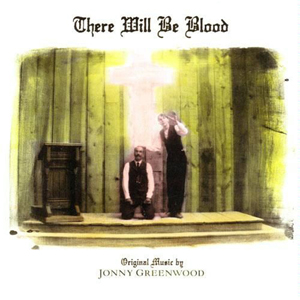
The first track is entitled “Open Space”, and features a mix of string instruments that slowly introduce us to the world of “There Will Be Blood”. The cellos and basses of this title track again showcased the nice deep base that the Transparent One’s were capable of producing.
I also wanted to try the Transparent One’s with some music of lesser quality. I started with an MP3 of Alicia Keys’ “No One” that I downloaded from iTunes some time ago with a free song coupon.

The Transparent One’s handled this lower sample rate track pretty well. While it was fairly easy to hear the dynamic compression that we expect from a track like this, I didn’t find the Transparent One’s too revealing of the lower quality stuff. On my reference system this track is almost unlistenable – everything is just crushed into the mid range and sounds totally flat. In this respect, I think the Transparent One’s are probably a little more forgiving than you might find in a more fully-fledged system. I also spent time clicking around on both Spotify and using internet radio – again, I did not find the Transparent One’s to be too revealing for lower quality audio and would say they performed will in these tests.
I wanted to get an idea of how the Transparent One’s stacked up against a complete system. For normal listening I use Usher Mini Dancer 2 floor standing speakers. I thought a comparison to bookshelf’s might be more appropriate so I shifted my surround Paradigm Studio 10’s to the front of my room and connected them to the L/R input of my Wyred4Sound MMC5. For apples to apples comparison, I defeated all room corrections in my Integra 80.2. As you might imagine, the Studio 10’s produced a different experience than the Transparent One’s. Returning to the 24/48 FLAC Phish files, I was reminded of the increased resolution that high sampled music can give – there was clearly a more detailed and fuller presentation from the Studio 10’s than was given by the Transparent One’s. While an admittedly unfair comparison, I think it is important to note that if your budget is more than ~$1000, it is possible put together a system that is will not only outperform the Transparent One’s, but will also be more versatile.
If I had a complaint about Transparent One’s, it’s the versatility I alluded to above. These are speakers made by music lovers for music lovers, to pair with a streaming source in a complete package. When I think about coaching friends and colleagues towards better sound, one of the first thing I tell them to do is stop using the built in speakers in their TV as soon as possible – for those on a tight budget, the Transparent One’s won’t help you do that. Yes, it is possible to use an audio-return channel on your TV to feed the transparent one’s through their analog input – this is a bit circuitous and really not that straight forward. If you are someone who only has room for only one system, I might encourage you to look towards look towards something that’ll not only get your some good 2-channel music, but also something that’ll allow you to pair with video a little easier, likely based around a receiver instead of powered speakers. This isn’t necessarily a knock specifically against the Transparent One’s, but one I though worth mentioning. Bottom line: for those on a limited budget, there are more versatile set-up’s that might fit your needs better.
Conclusions about the Vanatoo Transparent One Speakers
As you can probably tell from this review, I enjoyed my time with the Transparent One’s. These speakers are thoughtfully designed and pair well with any of a number of streaming solutions that are available out there right now. If you’re looking for a good, compact solution with audiophile quality sound for a satellite system, in a bedroom or living room for example, the Transparent One’s should be on your short list. They’ll also make a great option for people on a limited budget who want a music only 2-channel system. Obviously we like to tell everyone to try speakers first if possible – luckily Vanatoo offers a 30 day no questions asked return policy. Given them a try – I doubt you’ll be disappointed.


